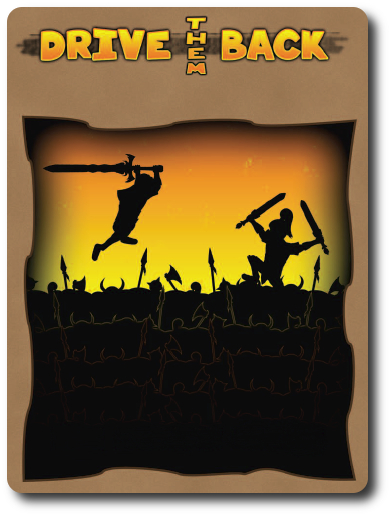
The Basics:
- For ages 5 and up (publisher suggests 12+)
- For 2 to 4 players
- Approximately 30 minutes to complete
Geek Skills:
- Active Listening & Communication
- Counting & Math
- Logical & Critical Decision Making
- Strategy & Tactics
- Risk vs. Reward
- Cooperative & Team Play
Learning Curve:
- Child – Easy
- Adult – Easy
Theme & Narrative:
- Draw your weapon and defeat a large army with only a handful of awesome warriors!
Endorsements:
- Gamer Geek approved!
- Parent Geek approved!
- Child Geek approved!
Overview
The legend goes something like this. The army was reportedly 500 soldiers strong and armed to the teeth. Every opponent who battled them lost and nothing but ruin was left in their wake. This army was now about to advance on a small town with no visible defenses except for a few lone warriors. The army officers scoffed and ordered their men to attack the fools who stood in their way. It was the last order they would ever give.
Drive Them Back, by Wedontknow Games (not a typo), is comprised of 66 Enemy cards, 30 Weapon cards, 50 Epic cards, and 25 Damage counters. The illustrations on the cards are over the top, highly stylized, cartoonish, and not in the slightest bit gory or violent, despite being a game about doing epic amounts of damage to a large army. The cards are made of thick cardstock and have the same level of durability as standard card games. The tokens are thick plastic and very durable. It is also worth noting that this game was a finalist in the Game Crafter’s cooperative game design challenge.
The Army Approaches…
To set up the game, first separate the cards into three different decks. These will be the Enemy deck, the Weapon deck, and the Epic deck. Each of the card types (Enemy, Weapon, and Epic) have unique backs which will make sorting the cards an easy task. Shuffle each deck thoroughly.
Second, deal out 3 rows of Enemy cards face-up. The number of Enemy cards in the rows is dependent on the number of players. For a 2-player game, each of the 3 rows will contain 6 Enemy cards. For a 3-player game, each of the 3 rows will contain 8 Enemy cards. For a 4-player game, each of the 3 rows will contain 8 Enemy cards. The first row is referred to as the “front line”. Place the Enemy deck to one side of the playing area.
Third, have each player randomly draw 1 Weapon card each. This is the player’s starting weapon. Each player can only ever have 1 Weapon card at a time. Place the Weapon deck and the Epic deck to one side of the playing area.
Fourth, set the Damage counters to one side of the playing area and determine the turn sequence order.
That’s it for game set up! It is suggested that all the players huddle together towards the Enemy front line. PREPARE FOR EPIC BATTLE! But first…
Knowing is Half the Battle
No, not really. GI Joe was full of it, but it’s important to understand how the cards in Drive Them Back work so as to do as much carnage as possible.
Know Thy Enemy
Each Enemy card has an image of the Enemy unit, the amount of damage it can take (which also counts as the card’s point value), and 1 or more icons that represent Enemy card actions. Those actions include:
- Advance – this icon means the Enemy card moves exactly one row towards the front line, but only if there is a space free (i.e. Enemy cards do not push each other out of eagerness to attack the players).
- Heal – this icon means the Enemy card removes 1 Damage counter from every Enemy card that is adjacent to it (adjacent is defined as any card that is directly up, down, left, and right of the card – never diagonal).
- Reinforce – this icon means the players draw one extra Enemy card when the players draw enemies to refill the ranks of the enemy army.
- Front Line Support – this icon means the Enemy card immediately jumps to the front line when it is drawn. If no space is free on the front line, this Enemy card is placed normally.
- Weapon Break – this icon means that a Weapon card used to strike the Enemy is destroyed, even if the attack was a killing blow!
- Shield Block – this icon means the Enemy is strong enough to stop the player’s Melee and Epic Attacks after the first hit if they are not killed.
- One Star Rank – this icon has no inherent meaning or action until matched with a Two and Three Star Ranking Enemy card.
- Two Star Rank – this icon means that a when the Enemy is targeted for damage, the closest One Star Rank Enemy will swap positions with the Two Star Rank Enemy card and take any and all damage instead.
- Three Star Rank – this icon means that a when the Enemy is targeted for damage, the closest One Star Rank Enemy will swap positions with the Three Star Rank Enemy card and take any and all damage instead. If there are no One Star Ranks available, the closest Two Star Rank will jump to their superior’s defense instead!
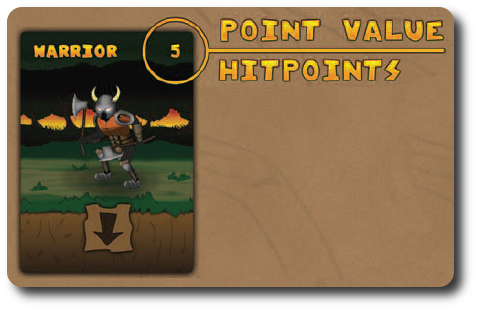
Know Thy Weapons
Each Weapon card has an image of the Weapon being wielded by the player and have names forged in the fires of awesome. Additionally, each Weapon cards lists the damage it inflicts and how many times it can be swung on the player’s turn.
Weapons can only be changed when they break. When a weapon does break, the player simply Discards the Weapon card and draws a new one. A player can only have a maximum of 1 Weapon card at a time. If the Weapon deck is exhausted, reshuffle the Weapon discard pile to create a new Weapon deck.
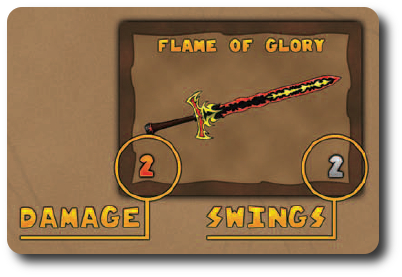
Know Thy Epicness
Each Epic card has an image of the EPIC attack being inflicted on the Enemy army. Massive damage! Additionally, each Epic card lists the damage it inflicts and the number of targets the attack hits. Some Epic cards also provide a bonus to the player’s Weapon damage and increase the number of times the weapon can be swung.
At anytime during the game, a player can “cash in” 10 points worth of Enemy cards to draw a new Epic card from the Epic deck. For every multiple of 10, the player can draw a new Epic card. There is no limit to the number of Epic cards a player can have at anytime during the game.
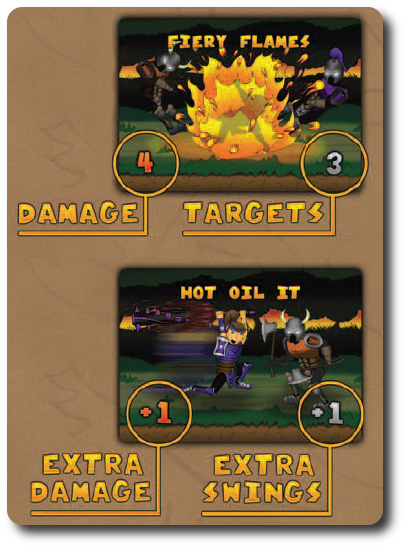
When Enemy cards are “cashed in”, excess points spent are lost. In other words, players cannot “bank” points, but players do not lose the points they spend. Instead, the Enemy cards that are “cashed in” are simply flipped to show the back of the card and set aside. These cards are no longer available to “cash in”, but they still belong to the player.
Waging Epic War
The game is played in turns, with each player taking a single turn in turn order sequence until the game either ends in victory or bitter defeat. A player’s turn is summarized here.
Step 1: Attack Them!
The player must decide to use their Weapon card (the default and always available attack) or an Epic card. The only time they get to use both is when the Epic card provides a bonus to a Weapon card’s damage and swing values.
When attacking with a Weapon card (referred to as a “Melee Attack”), the player is able to attack a maximum number of times equal to their weapon’s swing value. A player can, unless blocked or their weapon breaks, attack the same target multiple times as long as there are still weapon swings to be swung (I can’t believe I just typed that) or attack multiple targets. The first swing must always target any Enemy card in the front most row. After that, the player can continue to attack the same Enemy card or jump to an adjacent Enemy card. Damage counters are added to the Enemy card each time the Weapon is used (Enemies never dodge an attack). If an Enemy card takes damage equal to or higher than their Hit Points, the Enemy card is collected by the player and kept face-up next to them in a pile. If at anytime a player cannot target an Enemy card, this step ends regardless of how many swings the player might have left.
When attacking with an Epic card (referred to as an “Epic Attack”), the player will either use their Weapon card (if the Epic card has a plus “+” value for damage and swings) or target a defined number of Enemy cards for the damage noted on the Epic card. Unlike Melee Attacks, an Epic Attack can only target one Enemy card at a time. For example, if the Epic card has a Target value of 3, that means that 3 different Enemy cards will get hit by the Epic Attack’s damage. Like the Melee Attack, players must target an Enemy card in the front most row and then move to an adjacent Enemy card until the number of Enemy cards hit by the Epic Attack is equal to the Epic card’s target value or there are no adjacent Enemy cards that can be targeted. If an Enemy card takes damage equal to or higher than their Hit Points, the Enemy card is collected by the player and kept face-up next to them in a pile. Epic cards, once used, are discarded.
Step 2: Update Them!
Once the player has completed their attack, the Enemy advances using these sequential steps.
- Move all Enemy cards 1 row forward (forward most row is the front line) if possible. Enemy cards can only move a maximum of 1 row during this step and only if they have the Advance icon.
- Heal all adjacent units if the Enemy card has the ability to do so. One Damage counter is removed from each adjacent Enemy card. A card is adjacent if it is above, below, left, or right of the card; never diagonal.
Step 3: Draw Enemies
The Enemy reinforcements have arrived! At least 1 Enemy card is drawn from the Enemy deck and placed in the first available position behind the front line, but not in front of another Enemy card already in play. Enemies are placed starting with the leftmost position and going right. The maximum number of Enemy cards per row is determined by the number of players. If there are no available spots in the existing rows, a new row is started at the top leftmost position in the rows and columns.
For every Enemy card that has the Reinforce icon on it, an additional Enemy card is drawn and placed. Any Enemy card that is drawn that also Reinforces does not provide the Reinforce action until the end of the next round.
This ends the player’s turn. The next player in turn order sequence now starts with step 1 above.
Winning and Losing the War
The players win once every Enemy card has been defeated. When the last Enemy card is defeated, all the players now add the point values of all the Enemy cards they collected, including any Enemy cards they “cashed in” for an Epic card. While all the players have won the game, the player with the most points is awarded the title of “Most Epic Hero of the Battle!”
All the players lose and no title is given if an Enemy card is drawn during step 3 and its placement creates the start of a sixth row. The players have been overwhelmed, despite their awesome epicness.
Game Variants
If the players are finding the game to be too easy, the rules suggest that one additional column (not row) is added to the initial game set up. If the players are finding the game to be too hard, the players should reduce the number of columns by one.
To learn more about Drive Them Back and read the full rules, visit the game’s official web site or the game’s web page on the Game Crafter.
Prediction
It doesn’t take a mystic to know that Drive Them Back is going to be a BIG HIT with the Child Geeks. The entire game is set up like a video game with a huge army attacking a handful of lone super warriors. The weapons are over the top, as are the epic attacks. For example, there is a Weapon card named “Soul Reaper” (a giant scythe) and “Flame of Glory” (a wicked looking long sword right out of your favorite fantasy story). Not to be outdone, the Epic cards are truly “epic”. For example, there is the “Massive Tenderizer” (summon forth the world’s largest meat tenderizer) and my favorite, “Whale” (exactly what it sounds like – a giant whale falls on the Enemy – death by blubber!). Everything about the game’s presentation is big, bold, and best of all, epic. As such, we can safely assume the Child Geeks will fall over themselves to play this game because it is easy to play and even easier to put the massive smack down.
The Parent Geeks, depending on their video game and board game background, are either going to laugh a lot at the game’s humor or scratch their head in confusion because they can’t figure out why their Child Geeks are so excited. Regardless, the game rules lead me to believe the game will be a fun semi-cooperative for the family. All the players must work together, but they are also attempting to outdo each other with as much bravado and massive Enemy take downs as possible. Games like this tend to be fun for the family and often approved by the Parent Geeks unless the game play is terrible or the game’s theme, narrative, or components are not “family friendly”. But there is nothing to suggest that any aspect of Drive Them Back is “unfriendly” unless a Parent Geeks defines cartoonish epic attacks with no blood or gore as unsuitable. If they do, I feel for their little geeks because I bet their house isn’t much fun.
Gamer Geeks are a tough call on this one. They have recently been very reluctant to give their approval on games unless they demonstrate a real challenge as well as fun. Drive Them Back can be very challenging, but I don’t think Gamer Geeks will be so challenged that they will lose the game. At most, the battle might be very, very close. If the game keeps them engaged, feels tense, and moves at an exciting pace, the game is going to get their nod of approval. If it feels mechanical, repetitive, and doesn’t challenge the players to think through their moves, the Gamer Geeks are going to give it a pass.
And so, I sat down with my Child Geeks to play the game for the first time. I opened the box and it was immediately pounced on. My little geeks looked through every card, commented on every weapon, cheered for all the epic attacks, and discussed which was the toughest enemy. About 15 or so minutes later, I was able to teach them the game. It is amusing to note that teaching them the game only took 5 minutes after they took 15 minutes to look over every card. Since the game is all about simple math and logical thinking, this game should be very playable by my 5-year-old. The game play does suggest light tactics and strategy, but I don’t think any player will be at a serious disadvantage if they don’t recognize it. Really this game is about cooperatively kicking butt and the rewarding of most Epic Warrior is more of a player goal than a victory condition.
And so, after answering a few questions, demonstrating a player’s turn, and showing my little geeks how to buy and use Epic cards, we were ready to play. As my two little geeks reshuffled the decks, I asked them their thoughts on the game so far.
“Awesome! Awesome! Awesome!” ~ Liam (age 8)
“EEEEEPIIIIIIIIIIIIIIIIIIIIIIIIIIIIC!” ~ Nyhus (age 5)
Let’s see if this game is as epic as it wants to be or falls well short of the mark.
Final Word
Total and complete success. The Child Geeks we played the game with had a great time and bounced up and down excitedly during their turn and waiting for their team members to take theirs. At first, the Child Geeks didn’t demonstrate anything to suggest they were logically thinking through their attacks or using tactics and strategy to maximize the points they collected. It is important to note that the game rewards you for taking out stronger Enemy cards by giving you more points to spend on Epic Attacks. That, in return, allows the player to take down more enemies. If a player thinks through their moves, takes advantage of weak spots in the enemy line, and uses their attacks in the most efficient manner, they will be doing massive damage and collecting lots of points. If not, they will spend a great deal of their time simply “picking away” at the enemy. This is what we saw in the first few games with the Child Geeks and they lost as a result. They didn’t work together and didn’t focus on managing the threat. After discussing the game, the older Child Geeks decided on a group strategy and truly worked together. There were a few instances of “stealing kills”, but the majority of the game was a well orchestrated and surprisingly highly organized offensive from the Child Geeks resulting in a victory. Regardless of the ages of the Child Geeks, every one of them highly approved of Drive Them Back and demanded their parents get them a copy. Note that an older player will need to help the younger players with the math, but that was the extent of the help that was needed and asked for.
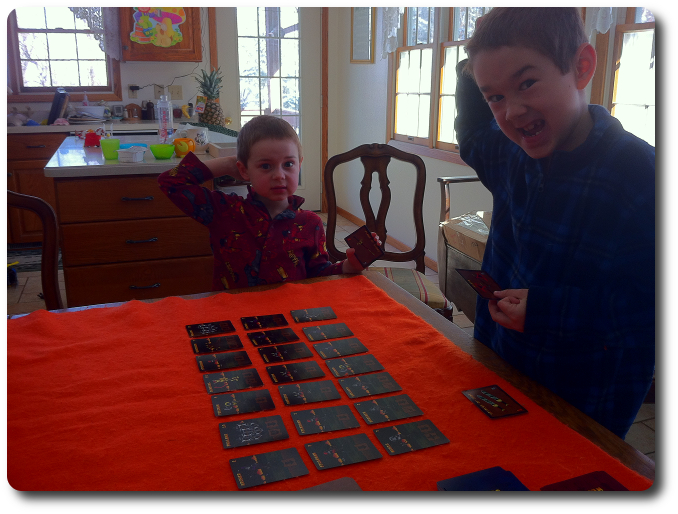
The Child Geeks prepare for EPIC BATTLE!
Parent Geeks, after being told to “buy this game right now”, wanted to see what all the fuse was about and sat down for a game. For the non-gamers, they were pretty lost at first. They acted exactly how you’d expect a person thrown in front of a massive army with a weapon they didn’t understand how to use. That is, clumsy, without direction, and terribly inefficient. All Parent Geeks, regardless of their game play experience, lost their first game. This frustrated them and they sat down for another. Like the Child Geeks, they learned from their mistakes and worked as a team. Victory was won due to their team work. Interestingly enough, the Parent Geeks focused more on winning the game as a group and didn’t put much time or effort in attempting to be the best warrior. To the Parent Geeks, the goal was to achieve victory, not to be the player who took down the most enemies. Based on their positive experience with the game and how much fun it was to play with their peers and family, the Parent Geeks gladly approved it.
The Gamer Geeks took no prisoners right from the start. They smashed through the enemy lines and often times looked to be working against each other as they plowed through the enemy. They won their first game, but it was a close one. Surprisingly close, actually, and the Gamer Geeks learned that the game could be won if the players worked together just enough to manage the threat. This emboldened them and they took another swing at the game, but this time focused on their own points. As a result, they lost the game. This really upset them and they started a third game. This time, they worked together but still took any opportunity to collect the most points by chaining attacks or finishing kills that their team members started. This game was won and the competition between the players was never offset by their cooperative play. Three different games played three different ways. In all three cases, the Gamer Geeks enjoyed themselves and hailed Drive Them Back as a fun and light game filler worthy of their gaming table. The Gamer Geeks would have liked to have seen more chances to switch weapons and more enemies come out at a time, but they quickly learned to use weapon breaker enemies to their advantage and with at least one Enemy card per turn coming out, there was always an army to battle.
Drive Them Back is a very enjoyable semi-cooperative. The players must constantly look for ways to chip away at the enemy lines in a logical way so that reinforcements do not add rows, weak enemies group together for killer combos through army advancement, and all attacks are performed with the utmost efficiency. For a player who likes to think through their moves, there is much to consider and to set up for future plays. Failure to consider, at minimum, the never-ending threat of the enemy will lead to the players loosing.
The game is very intuitive and would be an easy one to win as a team if it weren’t for the title of Epic Warrior that is only given to the player with the most collected points. This was a surprisingly large carrot that was a bit too tempting to ignore. This caused players to take what I would consider unnecessary selfish risks to steal kills and points instead of managing the threat of the army. This lead to laughter, frustration, and lots of enjoyable banter around the table, but also made the game much more difficult to win. The additional level of player competition turned out to be just one more thing to manage, but it was not necessary for group victory. Players tended to forget that and started to look at their team members as threats despite the large army that was attacking them. In Drive Them Back, your “enemy’s enemy” is not necessarily your friend, but they are partners. You need them and they need you, but only one player can be awarded the epic title of epicness. You must cooperate to win, but the level of cooperation is often times slim and just enough to keep the game going.
Over the top? Certainly! Silly? Without a doubt. Casual and fun? To a “T”. Well balanced and yet challenging? You bet your buckler, kiddo. It’s a great game filler for the Gamer Geeks, an enjoyable game for the family, and a card game version of a simple video wargame for the Child Geeks to scream over. Something for everyone with the only losers being the poor Enemy cards that have giant whales dropped on them. But, really, they had it coming.
“WWWWWWWWWWHHHHHHHHHHHHHHHHHHAAAAAAAAAAAAAAAAALLLLLLLLLLLLLLLLLLLLLLLLLLLLLLE!” (splat!)
This game was given to Father Geek as a review copy. Father Geek was not paid, bribed, wined, dined, or threatened in vain hopes of influencing this review. Such is the statuesque and legendary integrity of Father Geek.




Sign me up, I am ready to play Drive Them Back!!!